Shrimply Explained is currently undergoing renovations. Please don't buy anything yet. Thank you!

Many become interested in the shrimp keeping hobby with Neocaridina like cherry shrimp and blue dream shrimp but there are other fascinating shrimp species that may work for your aquarium! This lesson simply introduces some of those cool shrimp with a brief description and general care information to help determine if you’d like them in your tank. If you already know what shrimp you want, then feel free to skip this lesson.
A few things to note:
Ghost Shrimp (Plaemonetes paludosus)
Amano Shrimp (Caridina multidentate)
Whisker Shrimp (Macrobrachium lamarrei)
How to Tell the Difference Between Amano, Ghost, and Whisker Shrimp
Tiger Shrimp (Caridina cantonensis)
Crystal Shrimp (Caridina cantonensis)
Taiwan Bee Shrimp (Caridina cantonensis)
Cardinal Shrimp (Caridina dennerli)
Including Neocaridina davidii (formerly Neocaridina heteropoda), Neocaridina palmata (formerly Neocaridina zhangjiajiensis). Common breeds include red cherry, bloody mary, blue dream, green jade, orange sunkist, red rili, snowball shrimp, and many more.
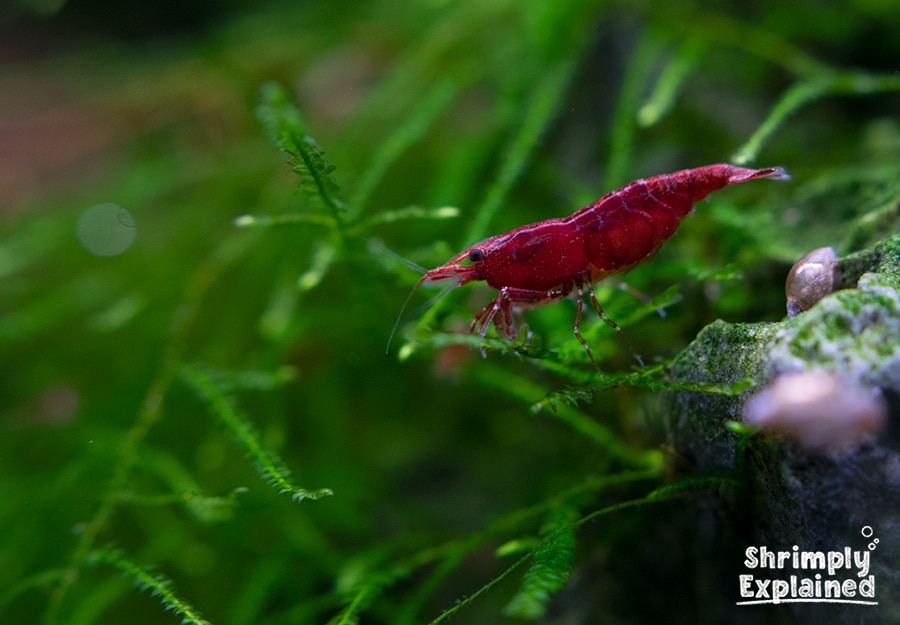
Neocaridina davidii - Female Red Cherry Shrimp - Photo from Shrimply Explained™ archives.
Originally found in the clear rivers of Taiwan, Neocaridina (neos) can now be found on at least 6 continents and are the most common variety in the hobby for two reasons:
Due to these traits, neos were some of the earliest freshwater shrimp species to be kept in aquariums around the world, although they look very different now than their ancestors from even 20 years ago. When first pulled from the wild, neos were typically clear with brown pigmentation on their shell. Years ago, a breeder found shrimp that had more red pigments and selectively bred them with others that had the same trait, eventually leading to the cherry shrimp you see today. Since then, a rainbow of colors have been discovered so just about anyone can find their favorite colored neos (except purple – so far. You might get lucky and find it!) In addition, there are various “grades” of each color depending on hue and shell opacity, with the highest grades having the most vibrant and solid colors.
(One of the reasons I like this hobby so much is that you never know exactly what the offspring will look like, especially if there is a strange mutation. You could have all red cherry shrimp and then one day see a blue-colored baby in your tank! With more than one tank, it becomes possible to separate the offspring with characteristics that you like to get a higher grade or experiment and make your own line. There are actually shrimp shows you can compete in, if you want to get deeper into the hobby.)
A few other characteristics worth mentioning:
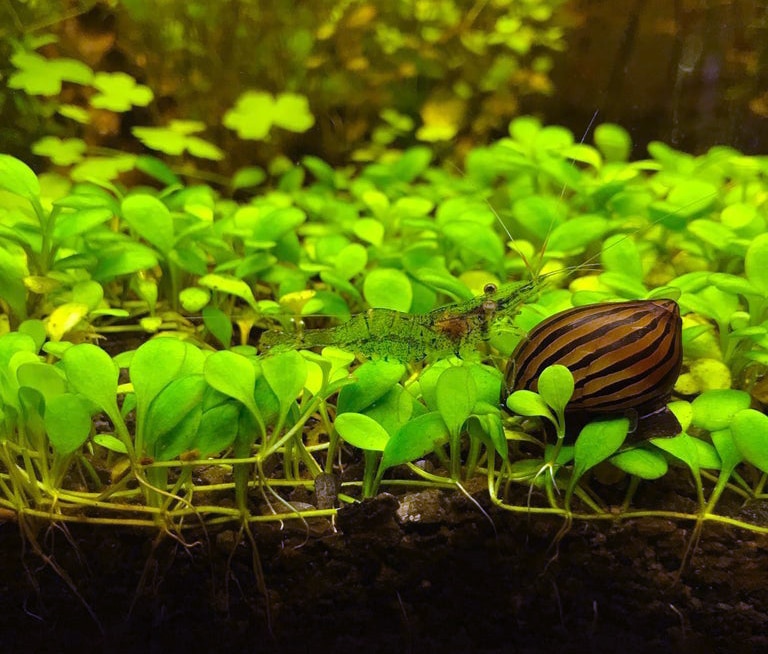
Plaemonetes paludosus - Female Ghost Shrimp - Taken and generously provided by reddit user u/ihugyou
Hailing from the United States is the ghost shrimp, which is sometimes referred to as a glass shrimp. They have been given these names due to their transparent nature, allowing you to clearly see all the organs in their body. In addition, they have a very distinctive hump in their abdomen that some might consider creepy. While ghost shrimp can blend into the background due to their transparency, they are difficult to look away from once you find one. This is part of the reason they are so popular in the hobby.
The other reason for their popularity is that ghost shrimp are extremely cheap, which is why they are often used as a food source for larger fish. When bred for food, these shrimp are typically kept in poor conditions, resulting in unhealthy shrimp that may be cheap but likely won’t last long in your tank. As such, it is important to check with potential sellers to see what their ghost shrimp are being bred for before buying.
Another potential problem is that ghost shrimp look similar to young Amano and whisker shrimp.
Even many articles online show an image of an Amano shrimp instead of a glass shrimp, so the confusion is understandable. To differentiate Amano and ghost shrimp, Amano shrimp have distinctive dots and dashes across the length of their shell while ghost shrimp have no markings on their shells. Amanos also do not have the distinctive hump that ghost shrimp have.
Whisker shrimp are more difficult to differentiate because they have the same hump and similarly translucent body. The main differences are a distinctive red/orange band on the upper antennae of adult ghost shrimp, along with smaller claws than whisker shrimp. In addition, whisker shrimp are much more aggressive and will attack other animals in your tank. Obviously, these characteristics may be difficult to see initially, so it is important to get ghost shrimp from a seller you trust.
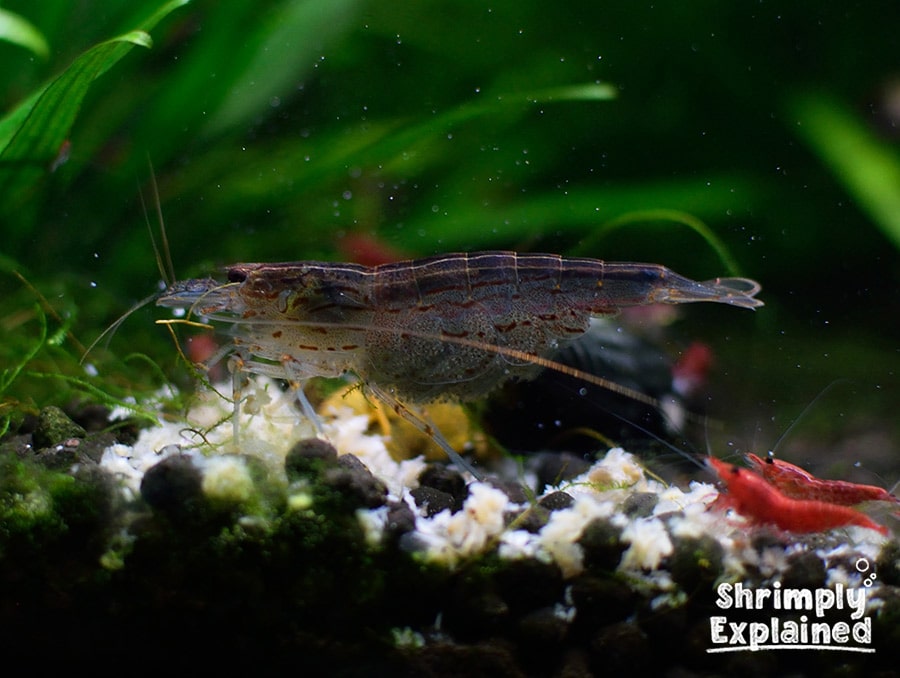
Caridina multidentate - Berried Female Amano Shrimp - From the Shrimply Explained Archives
Originating from the East Asian coastline, Amano shrimp (Amanos) are the best shrimp for cleaning your tank due to their voracious consumption of algae. This superpower was first popularized in the tanks of famous cyclist and aquascaper, Takashi Amano, which explains where the name came from. While they are great algae eaters, there are a couple other reasons to consider Amanos for your tank.
Amano shrimp personalities come out during feeding time. Unlike Neocaridina, who meander over when they sense food, Amanos quickly hunt down anything added to the tank to get there first and hoard it away - It's quite entertaining. While they can be aggressive during feeding time, Amanos are more like tea-cup poodles than rottweilers – All bark and no bite. Unfortunately, there are misleading stories online about how Amanos attacked other animals in the tank. This is because Amanos can sense when an animal is dying, far before humans can visually tell. As a result, it appears that they are attacking a healthy individual, when they almost never do. The only exception to this is if Amanos are starved of protein, in which case they will start attacking healthy animals in your tank to survive.
One aspect that can be considered a pro or con is that, while Amanos do breed in freshwater, their offspring do not survive. You will see your Amano shrimp carry eggs for 4-6 weeks (although they are ready to hatch much earlier) if you have a male and female, but all the larvae will die if you don’t move them to brackish water, which makes them difficult to breed. They evolved this way because Amanos naturally live in freshwater streams so, once the larvae hatch, they get swept out to sea and must find their way back to freshwater once they mature. Some shrimp keepers like that they don't have to worry about excess breeding while others get frustrated by how difficult the offspring are to raise.
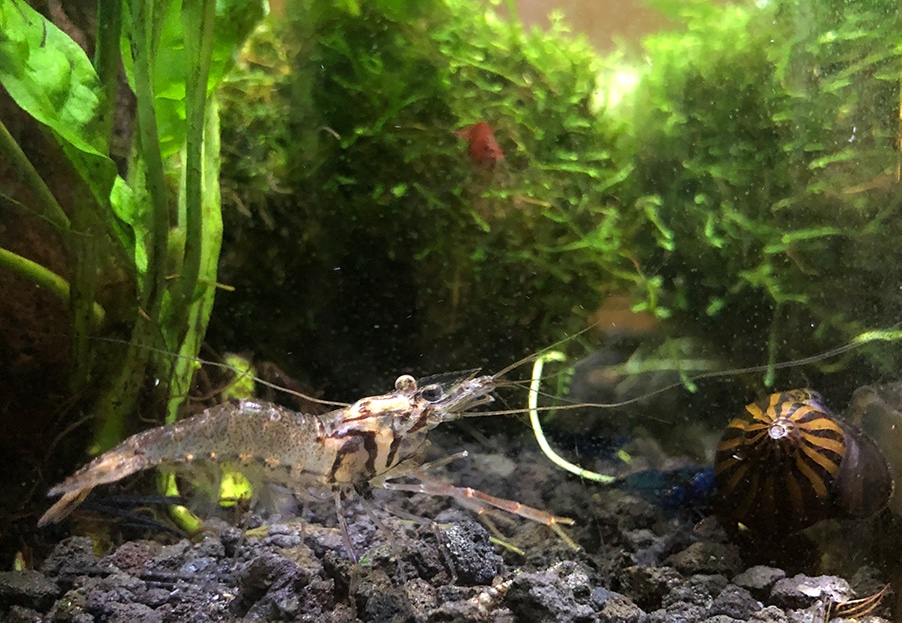
Macrobrachium lamarrei- Whisker Shrimp - Taken and generously provided by Christine Bonadonna
As with nearly all the shrimp on this list, the whisker shrimp originates from Asia, specifically in Southern countries like Thailand and Indonesia. They are the most common shrimp found in freshwater sources there so, obviously, keep them in a freshwater tank.
Whisker shrimp have clear bodies, like ghost shrimp, but have additional black or red stripes running along their head and sometimes the sides of their bodies. In addition, whisker shrimp are bigger and have longer, larger front claws that suit their aggressive nature. Due to their aggression, finding tank mates that won’t be killed by them means getting fish larger than a couple of inches, but anything that large will likely eat them, so it's a bit of a Catch-22. As such, it is easiest to keep whisker shrimp in a species-only tank, aside from a couple of snail companions.
Regarding breeding, there seems to be very little information available online for this species. It seems that their offspring can hatch in freshwater but require more specific conditions than some breeds. We will continue to do research on this species and update when more is learned. If you have any information of breeding and would like to help out, then please reach out via social media or email!
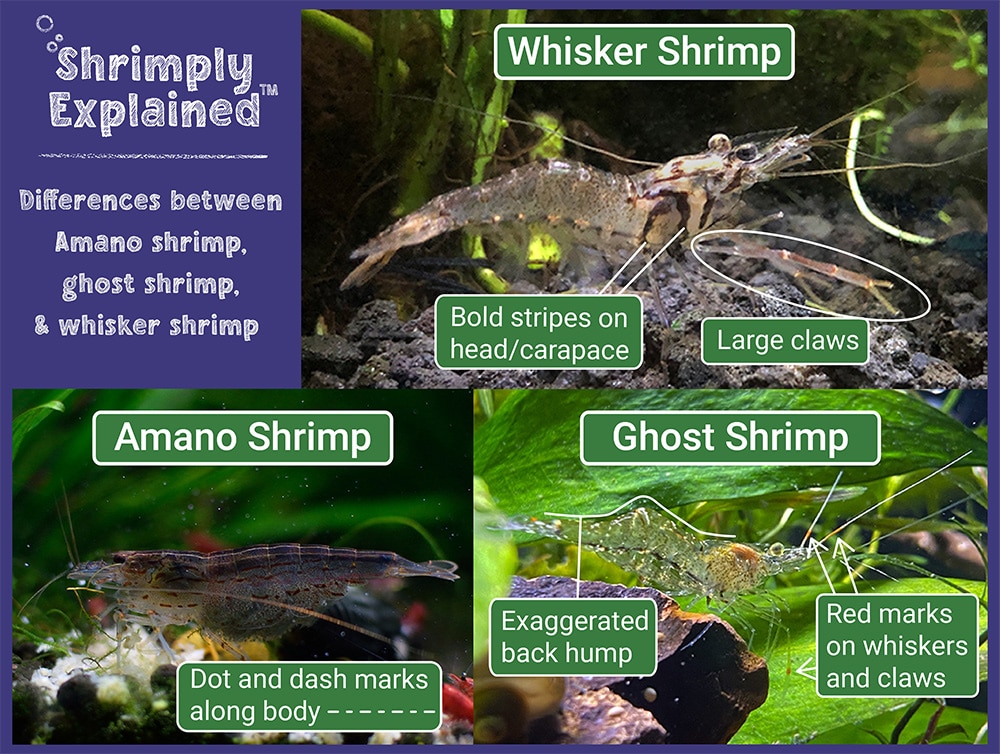
Special thanks to rauls_aquatics_and_reptiles for the ghost shrimp image and Christine Bonadonna for the whisker shrimp image!
Please note that these differences are most obvious once the shrimp are mature so may not be visible on juveniles seen at your local fish store. In addition, the various markings/stripes may become less vibrant during times of stress.
It is also important to mention that the Amano shrimp is berried (pregnant), which is why she is carrying all the tiny balls in her swimmerets. Otherwise, that area would appear more transparent.
Caridina mariae include breeds such as black tiger, blue tiger, red tiger, orange-eyed blue tiger (OEBT), and other variations. Caridina serrata include tangerine tiger, aurora blue/red, cheetah, and others.
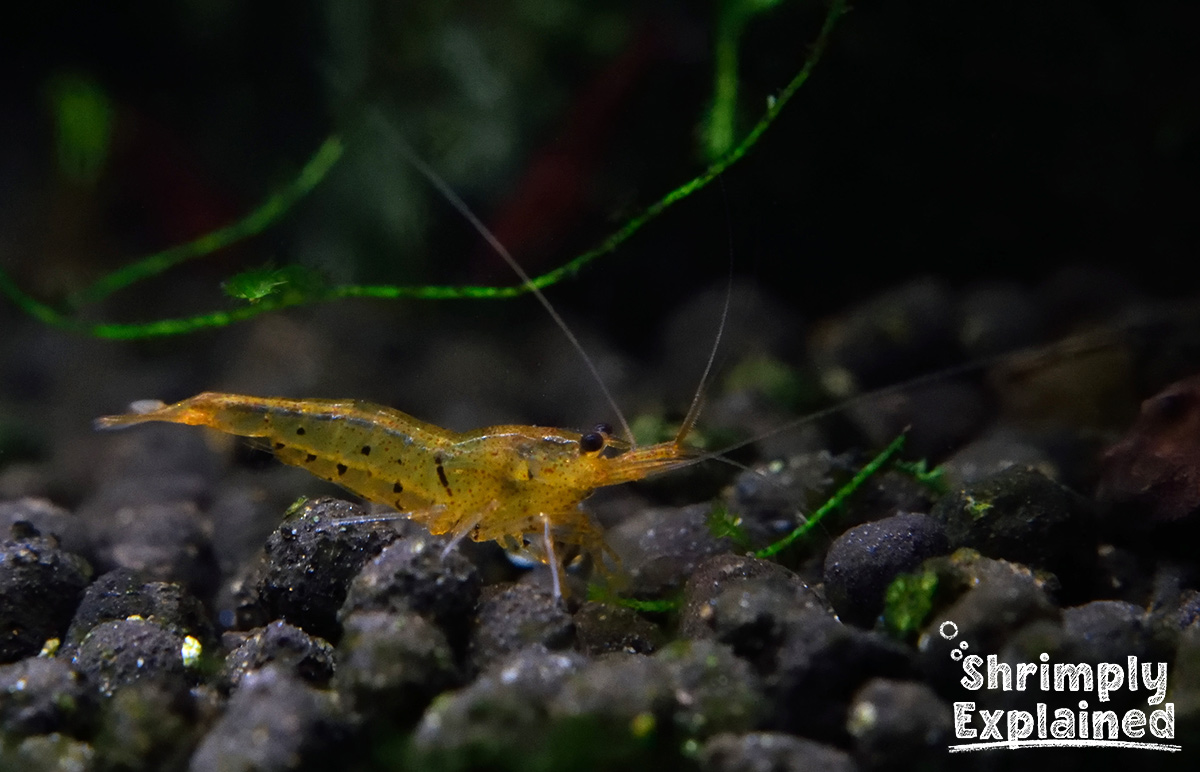
Caridina serrata - Tangerine Tiger AKA "TangTi" Caridina
These are typically the next step up from Neocaridina (neos) because tiger shrimp are also ornamental but slightly more challenging to keep. This is due to their evolution in different freshwater rivers that are typically more acidic and have a smaller range of parameters, but they are hardier than other Caridina like crystal shrimp and Taiwan Bees. Caridina mariae tend to do better in neo parameters than Caridina serrata in terms of hardiness and breeding success. That being said, softer, more acidic water matching Caridina cantonensis parameters is still best for both species.
In exchange for the increased difficulty (and price), you get striking black, blue, or red stripes running across their shells, which explains the name. In addition, breeds like the orange-eyed blue tiger have bright orange eyes that really stand out against their shell.
Because they are different species, neos and tiger shrimp cannot breed together so there is no risk of diluting the colors and patterns. These Caridina can breed with Caridina cantonensis to create interesting mixes, which is where Galaxy and Snowflake caridina come from.
Including crystal red shrimp (CRS) and crystal black shrimp (CBS)
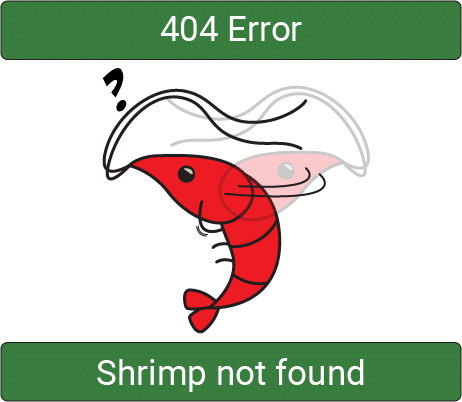
Your shrimp could be pictured here! Shrimply Explained is looking for high quality photos of crystal shrimp from the community. Reach out via social media or email to learn more.
Crystal shrimp (crystals) have bright splotches of red or black on their shell (like koi fish) and are of medium difficulty to keep. While they are the same species as tiger shrimp, crystals require more acidic--or softer—water and have an even smaller range of acceptable parameters. They are also generally more expensive to keep because they require active substrates and remineralized RO/DI water to maintain healthy conditions. Once you provide these conditions, crystal shrimp breed relatively easily and can overrun the tank with eye-catching bright colors that stand out against any plant or substrate. This explains why they are the second most popular breed of ornamental shrimp after neos.
Active Substrate - A term used for soil/gravel used to cover the bottom of the tank that affects water parameters. For example, Fluval Stratum is an active substrate that lowers pH, while crushed coral is an active substrate that increases pH.
Remineralized RO/DI water - Reverse Osmosis/Deionized water - Purified water that must have minerals added to it to make it suitable for an aquarium. Often used in shrimp tanks to achieve acidic conditions.
Any type of crystal shrimp, or other Caridina cantonensis, can breed together. Unlike breeding different colors of neos together, mixing Caridina does not result in boring brown offspring and instead creates a wide variety of fascinating colors and patterns. This allows you to experiment with crosses of different parents to eventually create your own line of shrimp with a unique coloration.
Including golden bee, blue bolt, red bolt, wine red, green hulk, shadow panda, black king kong, panda shrimp, and others.
If you’ve been paying attention to the species name, you might be thinking, “Has Shrimply been hitting the bottle or something? Why the hell are there two different Caridina cantonensis’ on this list?!
Well, for one, rude—Shrimply does not make mistakes. Any you see are from the editor and they will be punished accordingly.
Second, good job for catching that detail! Unlike Neocaridina (neos), which are all similar enough to survive in the same parameters, breeds of Caridina cantonensis do best in slightly different parameters so we do not group them together.
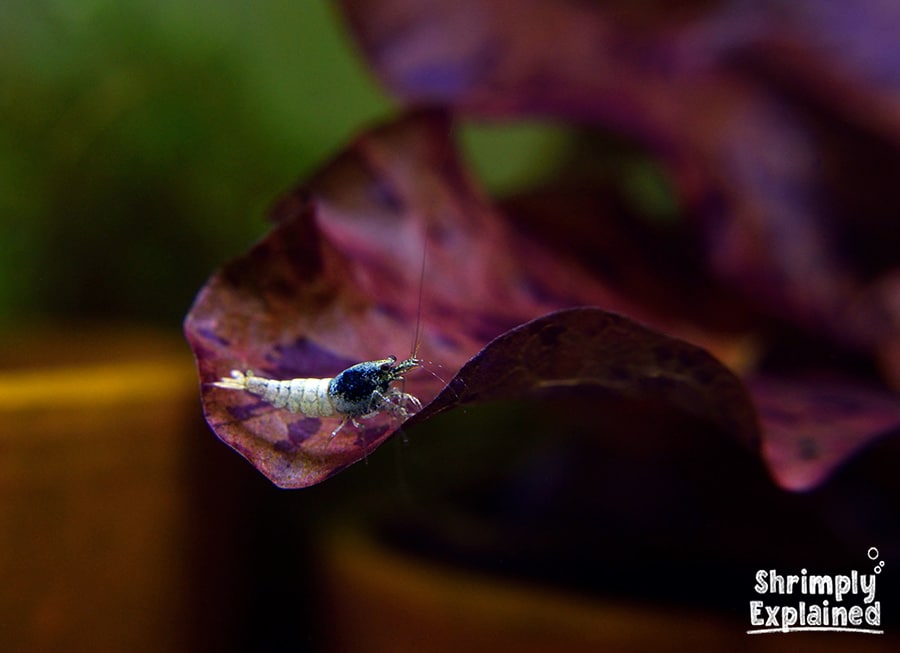
Caridina cantonensis - Blue Bolt Shrimp - From the Shrimply Explained Archives
Taiwan bee shrimp are essentially just crystal shrimp that have been extremely selectively bred, creating amazing colors but more expensive, sensitive, and slow-breeding shrimp. Due to their sensitivity, Taiwan bees need an active substrate, remineralized RO/DI water, and a well-established tank that has very stable water parameters. This makes them the most difficult breed of shrimp to care for, which is why they are not recommended for beginners.
Once you do have a bit of experience with shrimp keeping, then keeping Taiwan bees open up some of the most interesting colorations (like the fancy tiger, galaxy pinto or metallic blue boa) which are typically bred from a cross of Taiwan bee and tiger shrimp. These crosses create fascinating patterns and the tiger shrimp genetics make the shrimp hardier so even beginners may be able to keep these shrimp in the future.

Your shrimp could be pictured here! Shrimply Explained is looking for high quality photos of cardinal shrimp from the community. Reach out via social media or email to learn more.
Cardinal or Sulawesi shrimp originate from small lakes in the Sulawesi region of Indonesia. They are smaller than most freshwater shrimp, growing to only an inch or so in length, and require unique water conditions due to the high pH of their natural environments (8.4 pH in the lakes). As such, it is hard to find tank mates, so cardinal shrimp are often kept in a species-only tank or at slightly lower pH (7.8 or so) with Neocaridina.
Another unique aspect of their care is that cardinal shrimp are more reliant on algae than other species, which changes the tank setup somewhat. To promote enough algae growth, it is recommended that the tank is kept plant-free and that stronger lights are used.
These shrimp are not particularly well-known, but they are gaining popularity due to improvements in captive breeding and through viral videos. Certain breeds of cardinal shrimp have distinctive claws that look like white gloves which, combined with the graceful swaying of their antennae, makes it appear as if they are dancing.
One thing to consider when getting cardinal shrimp is that they are critically endangered. While the main cause is climate change affecting the lakes they live in, the aquarium trade has also reduced the population. Therefore, when buying cardinal shrimp, always ensure you are getting them from trustworthy breeders that are not selling wild-caught ones.
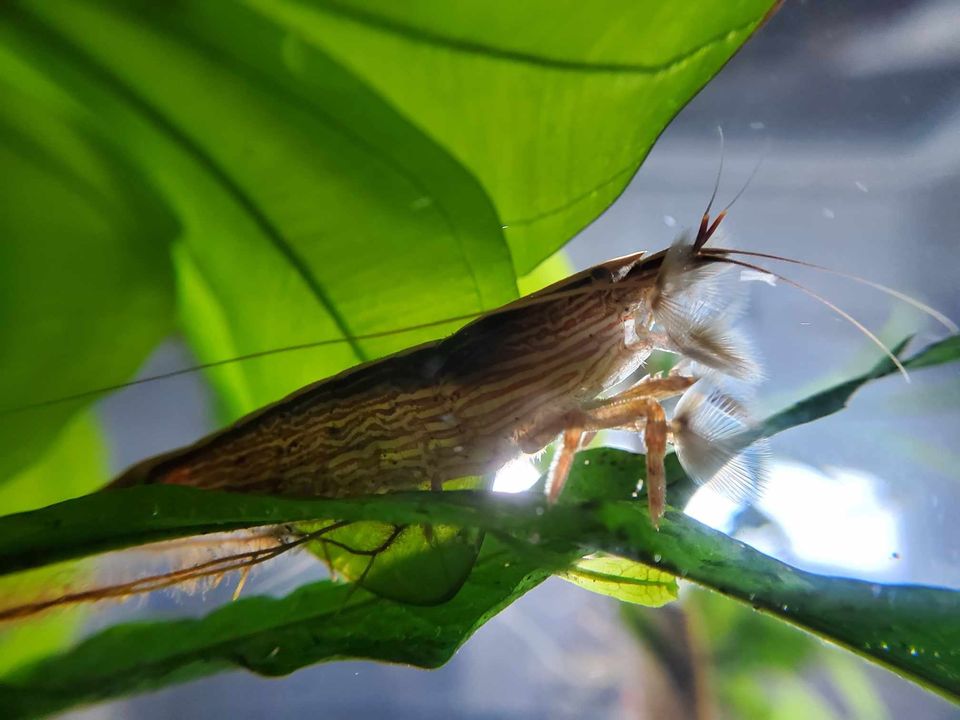
Bamboo shrimp are larger than most of the shrimp on this list, coming in at roughly 3” long with a very thick body. Brown or red stripes meander along the side of their shells and a white stripe runs along their back from head to tail. This makes it easy to spot bamboo shrimp when they are out but they are generally shy and often tuck themselves out of sight.
Unlike most other species, bamboo shrimp have fans that they hold up in a current to catch floating debris, instead of scraping debris off of the bottom of the stream. In areas with high water flow, groups are often seen moving their fans in coordination like a crowd at a concert as they feed. While this spectacle is impossible to replicate in most home aquariums, it is still enjoyable to watch even a single one feeding with its smooth and graceful fan movement.
To create a healthy habitat for bamboo shrimp, you need two things: large amounts of debris in water and a high flow rate.
Regarding breeding, bamboo shrimp have eggs that hatch into larvae and get carried downstream to toward saltwater to mature. This makes them extremely difficult to breed, which is why most bamboo shrimp found in-stores are wild-caught. On the bright side, the larvae are great food for nano fish in your tank.
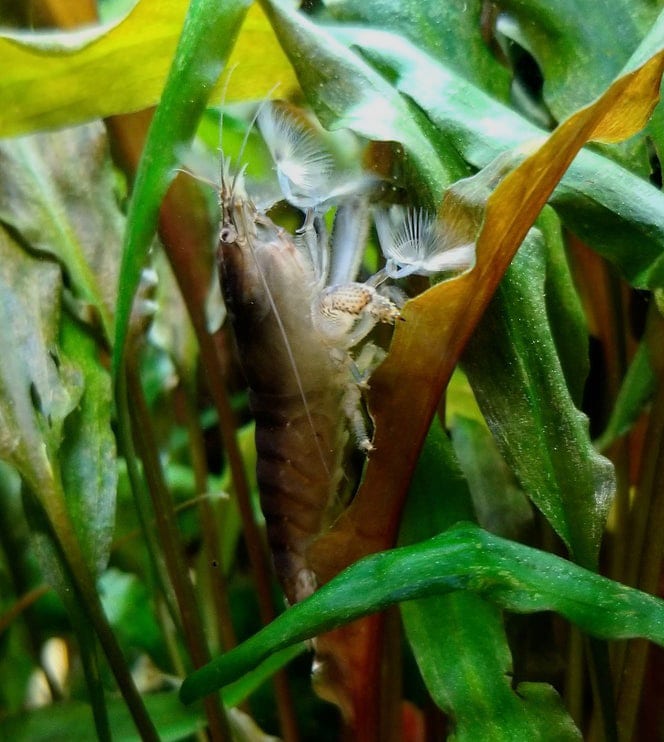
Atya ganonensis - Vampire Shrimp - Taken and generously provided by Wekiva Aquatics
Vampire shrimp are the largest shrimp commonly kept in aquariums, ranging from 5-6 inches as adults. Their size allows for a wider variety of tank mates than other shrimp once they are fully grown but they are still surprisingly good at hiding.
In terms of appearance, vampire shrimp look like bamboo shrimp with their thick bodies and fans for filter-feeding. The main difference is their coloration, as vampire shrimp do not have stripes and tend to have a white or blue shell. In addition, vampire shrimp have noticeable dark bumps on their front legs. The tips of these front legs often have a dark red coloration that almost looks like blood, which is where their name comes from.
Because vampire shrimp are filter feeders, they require high flow rate and a well-established aquarium with water that is not overly-filtered to ensure they get enough food. Their large size means they need more food than bamboo shrimp, which is why owners often target-feed vampire shrimp by releasing powder food directly in front of their fans.
Hopefully, this opened your eyes to all the types of shrimp you can keep in your aquarium! The rest of the Shrimp School does not focus on one species of shrimp but rather provides the tools you need to successfully care for any shrimp. Continue to the next topic (SB103) to learn all about important water parameters so you have complete control over your tank.